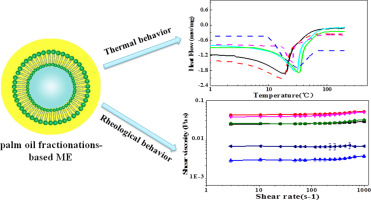Journal of Molecular Liquids ( IF 6 ) Pub Date : 2020-01-18 , DOI: 10.1016/j.molliq.2020.112527 Xiaoxue Liu , Qing Li , Xiaoxing Gao , Chao Lu , Leping Dang , Zhanzhong Wang

|
The conversion and utilization of agricultural biomass have shown great prospects in the development of new bio-based materials. In this work, we presented palm oil fractionations having different melting points (24 °C, 33 °C and 43 °C) to fabricate microemulsion (ME), aiming to broaden renewable biomass-based materials basestocks. The palm oil fractionations were used as the continuous phase to formulate W/O ME. According to pseudo-ternary phase diagrams, the largest ME regions were formed with Span80 as the surfactant when the ratio of palm oil (LMP, MMP and HMP) to composite surfactant phase were 6:4, 1:9 and 7:3, respectively. Dynamic light scattering (DLS) and transmission electron microscopy (TEM) confirmed droplets size of synthesized ME were 150–500 nm. Differential scanning calorimetry (DSC) results demonstrated thermal stabilities of designed ME were markedly enhanced. Rheology results showed synthesized ME exhibited excellent ability in anti-shearing changing, which led to a potential application in biomass-based materials, especially in requiring high anti-shearing fields.
中文翻译:

棕榈油基微乳液:制备,表征和流变性能
农业生物质的转化和利用在新型生物基材料的开发中显示出广阔的前景。在这项工作中,我们提出了具有不同熔点(24°C,33°C和43°C)的棕榈油分馏物,以制造微乳液(ME),目的是拓宽可再生生物质基材料的基础油料。棕榈油馏分用作连续相以配制W / O ME。根据伪三元相图,当棕榈油(LMP,MMP和HMP)与复合表面活性剂相的比例分别为6:4、1:9和7:3时,以Span80作为表面活性剂形成了最大的ME区。 。动态光散射(DLS)和透射电子显微镜(TEM)证实了合成ME的液滴尺寸为150-500 nm。差示扫描量热法(DSC)结果表明,设计的ME的热稳定性得到了显着提高。流变学结果表明,合成的ME表现出优异的抗剪切变化能力,从而潜在地应用于生物质基材料,特别是在要求高抗剪切领域中。



























 京公网安备 11010802027423号
京公网安备 11010802027423号